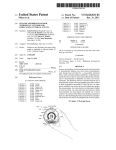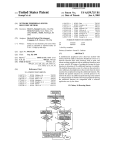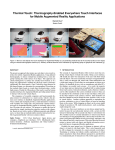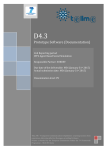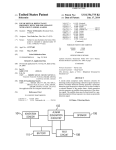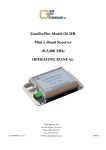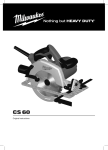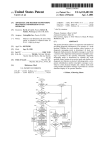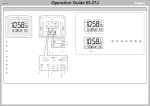Download @g“ Ag“
Transcript
US006223223B1
(12> Ulllted States Patent
(10) Patent N0.:
Kumpf et al.
(54)
(45) Date of Patent:
NETWORK SCANNER CONTENTION
5,933,580 *
HANDLING METHOD
5,946,458 *
5,968,138
(75)
Inventors: David A_ Kumpf, Rockhn; Glenn R_
Notice:
*
6,101,555 *
Apr. 24, 2001
8/1999 Uda m1. ............................ .. 710/19
8/1999 Austin et a1.
10/1999
Clough
358/1.15
... ... ... ...
* cited by examiner
Smith, Pittsburgh, PA (US)
Primary Examiner—Mehmet B. Geckil
(57)
. . . . ..
710/8
8/2000 Goshey et a1. ..................... .. 709/301
Garcia, Grass Valley; Dean L. Scoville,
Auburn, all of CA (US); David L.
(73) Assignee: Hewlett-Packard Company, Palo Alto,
*
US 6,223,223 B1
ABSTRACT
CA (Us)
AnetWork peripheral support method including a client With
Sub'ect
to an y disclaimer, the term of this
J
a general purpose software capability and a server connected
to the peripheral. The server of the present invention Waits
patent is extended or adjusted under 35
U.S.C. 154(b) by 0 days.
for a client to attempt to open a connection With the
peripheral. The client sends a peripheral connection request
via a data packet to the server, and the server accepts the
(21) APP1-NO-3 09/163,496
(22) Filed,
Sep_ 30’ 1998
connection. The server determines an availability of the
peripheral and locks the peripheral so that it cannot be used
(51)
(52)
(58)
by other clients. Thereafter, the server opens a connection
With the peripheral, if it is available, and noti?es the client
of the peripheral availability- The server then Waits for
predetermined data from the client, which When received,
Int. Cl.7 .................................................... .. G06F 15/ 16
US. Cl. ........................................... .. 709/227; 709/203
Field of Search ................................... .. 709/227, 203,
709/223, 224, 201, 217, 218, 219; 710/8,
results in the client having control of the peripheral for at
19
least a ?rst predetermined time period, and When received
sends the data to the client. The server closes the connection
(56)
References Cited
With the client upon completion of sending the data to the
client.
U.S. PATENT DOCUMENTS
5,913,088 *
6/1999 Moghadam et al. ............... .. 396/311
15 Claims, 5 Drawing Sheets
10
(JET DIRECT EX)
NETWORK
14
CLIENT
@g“
12
CLIENT
Ag“
@E.
12
U.S. Patent
Apr. 24, 2001
Sheet 1 0f 5
US 6,223,223 B1
SERVER
(JET DIRECT EX)
NETWORK
l4
CLIENT
12
CLIENT
12
U.S. Patent
Apr. 24, 2001
Sheet 2 0f 5
US 6,223,223 B1
LEGEND
START SCAN
CLIENT
CLIENT
OPERATIONS
Y
W18
GET SERVER
<
ADDRESS
''' "SERYER '''' "
;
OPERATIONS
‘A20
Y
OPEN NET CONN
TO SERVER
m
22
/
~
3
START IDLE
:
TIMER
................ -
SEND BUSY ("01")
\ _
’ ‘56
TO CLIENT
'
GET NAME OBJ
FROM SERVER
W
TO BUSY
' ‘58
38
44
+
DISPLAY BUSY
;
_
W
+
CLOSE CLIENT
CONNECTION
W52
'“65
5
SEND OK ("00")
;
TO CLIENT
'H-SNVRJ-CLIEXIZILII’WUK
(SEE FIG 2C)
66
7
SELECT NEW
CLIENT SETS
NAME OBJ
SERVER
@
FIG. 2A
U.S. Patent
Apr. 24, 2001
Sheet 3 of5
US 6,223,223 B1
LEGEND
PROMPT FOR
................ __
DOCUMENT
‘A72
START IDLE
W
‘
TIMER
CLIENT
5
OPERATIONS
SERVER
:L
OPERATIONS
74
V
WAIT FOR
DOCUMENT
DOC
m76
TIMEOUT
CLOSE
READY?
»
so
I ______ -1 _____ __
YES
: SERVER CLEANUP
1
START SCAN
CA
(SEE FIG 2C)
92
EMRCANDA'TA'M ,_
:
TRANSFER
94
84
ER
E0]
CLOSE
95
m
CONNECTION
SAVE SCAN
DATA
f
CONNECTION
DISCARD SCAN
96
DATA
m
DISPLAY ERROR
100
MESSAGE
?liViiciéA
' 'M
"1P"
-——-———>'
(SEE FIG 2C)
“A
102
m
104
U.S. Patent
Apr. 24, 2001
Sheet 4 0f 5
US 6,223,223 B1
LEGEND
' """""""" "
:
5
CLIENT
SERVER
CLEANUP
OPERATIONS
5' "" "S-I~1-l{-\;l§l-{ "" "
:
5 CLOSE NETWORK 5
;
CONNECTION
' ‘66b
5
CLEAR NAME
<--5
5
AND ADDR OBJS
66c
CHNL
OPEN?
I
5
-
_
_
-
_
-
_
_
-
-
-
NO
-
-
-
-
-_
CLOSE SCAN
I
5
\
I 666
ENSURE SCAN
SET STATE
IDLE T0
, ------ "I------ -~
66g
OPERATIONS
US. Patent
Apr. 24, 2001
US 6,223,223 B1
Sheet 5 0f 5
LEGEND
EVENT OR
ACTION
SEND NETWORK
DISCONNECT
T’
\.-\
T
27b
RECEIVE NEGATIVE
RESPONSE TO OPEN
CHANNEL REQUEST
28
RECEIVE NETWORK
CONNECTION, SEND OPEN
CHANNEL REQUEST
RECEIVE NEGATIVE
RESPONSE TO OPEN
TO PERIPHERAL
CHANNEL
»\
.
27a
\-\
REQUEST
29
\'\ 27
PERIPHERAL
g
POWERED-OFF/
<
OPEN-WAIT
P>
RECEIVE
DISCONNECTED
T
NETWORK
"57 6
30
PERIPHERAL
RECEIVE POSITIVE
RESPONSE TO OPEN
POWERED-OFF!
CHANNEL REQUEST
DISCONNECTED
DISCONNECT
\'\
33
K
T
27c
ACTIVE
RECEIVE POSITIVE
RESPONSE TO OPEN
32
CHANNEL
RECEIVE CLOSE
CHANNEL
RESPONSE
Cx
REQUEST K
271
IDLE TIMEOUT,
CLOSE NETWORK
CONNECTION
27h
RECEIVE
NETWORK
DISCONNECT
\-\
PERIPHERAL
27d
POWERED-OFF!
DISCONNECTED
L
\—\
V
V
27f
SEND CLOSE
CHANNEL REQUEST <-———
K
27j
TO PERIPHERAL
(ji
\-\
CLOSE-WAIT
36
PIG. 3
US 6,223,223 B1
1
2
NETWORK SCANNER CONTENTION
HANDLING METHOD
In one aspect of the present invention, the server waits for
a client to attempt to open a connection with the peripheral.
When the client sends a peripheral connection request via a
data packet to the server, the server accepts the connection.
The server determines an availability of the peripheral and
locks the peripheral so that it cannot be used by other clients.
Thereafter, the server opens a connection with the
The present invention generally relates to software and
?rmware, i.e., software embedded on a system, and more
particularly to software and ?rmware for supporting scan
ners over a network.
Scan peripheral vendors typically provide custom soft
ware that takes advantage of features of the product,
however, the custom software is typically written to com
municate only with a single device over a local interface,
10
such as a SCSI bus or a parallel port. While the local
peripheral, if it is available, and noti?es the client of the
peripheral availability. The server then waits for predeter
mined data from the client, which when received, results in
the client having control of the peripheral for at least a ?rst
predetermined time period, and when received sends the
data to the client. The server closes the connection with the
interface design is simple, the design fails to address issues
client upon completion of sending the data to the client.
that occur when the peripheral is attached to a network.
Thus, attached scanners cannot utiliZe the custom software 15
DESCRIPTION OF THE DRAWINGS
and associated features.
A problem exists with scanners and other peripherals
FIG. 1 is an overview of the network system;
attached to the network since multiple users can access the
FIGS. 2A—2C are How charts of the network server
peripherals. Scanners, for example, typically require some
embodying the present invention; and
setup before starting an actual scan. If no controls are in
place, contention between clients could occur where one
client sends commands to set the scanner resolution, page
FIG. 3 is a How chart of a state machine located in the
server embodying the present invention.
siZe, and other options in preparation for starting a scan, at
TABLE OF ACRONYMS
the same time another client is issuing similar commands to
the same scanner. One client’s commands could overwrite 25
the commands of another client. Similarly, one client can
send commands to reset the scanner while another client’s
scan is in progress, and effectively abort the other client’s
scan job.
the several acronyms:
ASCII=American standard code for information inter
change.
Another problem exists in network scanning, when a
scan connection is inde?nitely held open by one client.
CPU=central processing unit.
ID=identi?cation.
While the connection remains open, other clients are unable
to access the scanner. Thus, there is a need for a software that
has a timeout and a recovery to keep any one client from
tying up the scanner for too long.
35
Another problem exists with network scanning since the
peripheral is usually centrally located and not visible to the
IHV=independent hardware vendor.
IP=internet protocol.
MFPDTF=multifunction peripheral data transfer format.
MIB=management information base.
PC=personal computer.
SAP=service advertising protocol.
client, device status is typically not readily available to a
network client. With locally attached peripherals, peripheral
SCL=scanner control language.
SLP=service location protocol.
status can usually be determined either visibly, due to the
proximity of the peripheral, or by viewing error messages
reported by the local operating system or local software.
Thus, device error messages reported to an application
running on one client’s personal computer (PC) are not
propagated to other clients’PCs on the network.
This patent utiliZes several acronyms. The following table
is provided to aid the reader in determining the meaning of
SNMP=simple network management protocol.
SPX=sequenced packet exchange.
45
Accordingly, it is a primary object of the present inven
TCP=transmission control protocol.
DETAILED DESCRIPTION
tion to provide an improved server apparatus that can handle
contention on the network.
Another object of the present invention is to provide such
Broadly stated, the present invention is directed to an
improved method in the form of software and ?rmware for
an improved apparatus which can recover to keep a client
from tying up a scanner for too long on the network.
particularly, the present invention is able to provide an
supporting a scan peripheral over the network. More
improved server apparatus that can handle network conten
Yet another object of the present invention is to provide
tion situations, and can provide a connectionless protocol for
meaningful error messages to the client on the network.
control data and a connection-oriented protocol for scan
Other objects and advantages will become apparent upon
reading the following detailed description, in conjunction
55
improved server that can recover from a client tying up, but
not using a scanner for an extended period.
with the attached drawings.
SUMMARY OF THE INVENTION
The present invention is directed to an improved method
in the form of software and ?rmware for supporting a scan
peripheral over the network, whereby an improved server
apparatus can handle network contention situations, and can
provide a connectionless protocol for control data and a
connection-oriented protocol for scan data. Additionally, the
present invention provides an improved server that can
recover from a client tying up, but not using a scanner for an
extended period.
data. Additionally, the present invention provides an
Turning now to the drawings, and particularly FIG. 1, a
server 10 waits for a client 12 on a network 14 to establish
a connection with at least one peripheral 16. For purposes of
the present invention, the peripheral 16 is a scanner. The
server 10 of the present invention waits for the client 12 by
listening for a network 14 scan connection on a scan port
utiliZing, for example, a transmission control protocol/
65
internet protocol (TCP/IP) or sequenced packet exchange
(SPX) protocol. While the server 10 referred to is used as
part of a Hewlett-Packard JETDIRECT EX box package, it
US 6,223,223 B1
3
4
is contemplated that the server 10 can be part of a card that
connects via a bus interface to the peripheral 16, or as part
the scanner is not BUSY, then the server starts a server-idle
timer (block 56). The server-idle-timer acts so that one client
of an internal central processing unit (CPIJ) of the peripheral
12 cannot tie up the scanner for more than a threshold time
16. The JETDIRECT EX box is shoWn and described in a
HeWlett-Packard user manual, part no. 5967-2290, and is
period Without data being sent or received betWeen the client
12 and the scanner before the server-idle-timer expires. A
threshold time period of ?ve minutes Was found to be
desirable but can be changed to suit the clients’12 needs.
incorporated by reference herein.
Referring to FIG. 2, a user prompts the client 12 to send
a scan connection request to the server 10 scan port (block
18). The client discovers a neW netWork scan server address
or retrieves a previously stored address (block 20). A pre
ferred discovery technique is disclosed in a commonly
oWned co-pending application to Kumpf et al. ?led concur
Since the scanner is not BUSY, the server 10 locks the
scanner, i.e., prevents other clients 12 from using the
10
The server 10 also sets a scan oWner address SNMP MIB
rently hereWith and entitled Networked Peripheral Server
object to the client’s netWork 14 address and the scan oWner
Discovery Method. That application is incorporated by
reference herein. After the client 12 sends the scan connec
tion request to the server’s scan port, the server 10 auto
name SNMP MIB object to an empty string (block 60).
15 Thus, the client softWare can set the scan oWner name SNMP
MIB object so that other clients 12 can determine Which
client 12 has control of the scanner, as utiliZed above.
Thereafter, the server 10 attempts to establish communi
cation With the scanner by opening a logical scan channel
(block 62), and determines Whether or not the scan channel
matically accepts connection With the client 12, hence
establishing a netWork connection betWeen the client 12 and
the server 10 through an exchange of data packets (block
22). After the client 12 has connected to the server 10, the
server 10 checks the state of an internal state machine to
connection Was successful (block 64). The server 10 opens
a communication channel to the peripheral for scanning. The
determine Whether or not the scanner is available (block 24).
The server 10 contains the state machine (shoWn in the
flow chart of FIG. 3) Which represents various internal states
that key off external events (blocks 27a through 27j) to
25
represent a current state of the scanner. For example, the
internal state of the state machine changes from the scanner
AVAILABLE state (block 28) to an OPEN-WAIT state
preferred embodiment is a logical channel opened When
needed and multiplexed With other logical channels used for
other purposes, such as printing. HoWever, if the peripheral
does not support multiple channels across the communica
tion link With the server, scanning is still possible, but other
services Will not be able to communicate at the same time.
Also, the scan channel can be opened once at initialiZation
(block 30) When the server 10 attempts to open a connection
With the scanner (block 29). Likewise, the internal state
changes from an OPEN-WAIT state (block 30) to an
ACTIVE state (block 32) When the scan channel opens
and kept open betWeen scan jobs. This is not preferred,
(block 33). An OPEN-WAIT-CLOSE state (block 34) occurs
When a netWork connection is terminated (block 35) While
Waiting for the peripheral 16 to respond to an open scan
scanner, by setting the scan status SNMP MIB object to the
integer one to indicate that the scanner is BUSY (block 58).
35
channel request. A CLOSE-WAIT state (block 36) occurs
hoWever, because it ties up peripheral and server resources
When there is no scan job in progress.
If the scan channel open request fails, then the server 10
returns, for example, 45 an ERROR “02” status string to the
client 12 on the netWork connection as part of a data packet
on the netWork connection to indicate that the scanner is not
When the server 10 sends a close scan channel request packet
available (block 65). For example, the “02” status occurs if
to the peripheral 16 (block 37).
a cable connecting the server 10 to the scanner has detached
Returning to FIG. 2, if the internal state of the server 10
is in any other state than available, the server 10 sends a
scanner busy status, for example “01”, to the client 12 (block
or the peripheral 16 does not support scanning.
After the client 12 sends the data packet containing the
38). All scanner server statuses used herein are strings of tWo
ASCII characters. “01” in ASCII is transferred as an octet
With the value 48 in decimal folloWed by an octet With the
shoWn in FIG. 2C. The cleanup subroutine involves deter
mining Whether a netWork connection is open (block 66a).
value 49 in decimal. Other methods of encoding the status
status string, the server 10 invokes a cleanup subroutine as
45
are apparent to one skilled in the art. Importantly, as the
client 12 receives the result code from the server 10, a result
of BUSY or “01” prompts the client 12 to obtain a current
If the netWork connection is open, the server 10 closes the
netWork connection With the client 12 by sending a packet
to close the netWork connection (block 66b). Additionally,
the server 10 clears the oWner name and address SNMP MIB
objects by setting the MIB objects to the empty string (block
oWner name from the server 10 (block 44), and display a
66c). Next, the server 10 determines Whether the scan
channel is open (block 66a) Since the scan channel is not
open at this stage in the method, the server 10 merely sets
BUSY message using the name (block 46). Preferably, the
client 12 obtains the name by sending an SNMP query of a
oWner name management information base (MIB) object,
hoWever the server 10 could send the oWner name MIB
the scan status SNMP MIB object to the integer Zero to
object over the netWork connection before the netWork
connection is closed. By using the oWner name MIB object
indicate that the scanner is IDLE (block 66g).
While the server 10 performs the cleanup operation, the
55
the client’s message can include the name of the current
user. This enables the user attempting to open the connection
client 12 checks the data packet and displays an error
message stating that the server 10 could not communicate
locate the person currently using the scanner. It is recogniZed
that in some situations this may be a security issue so the
client softWare can provide an option not to supply a oWner
With the scanner and prompts the user to determine if the
user Wishes to select another server 10 (block 67). If the user
so indicates, the client invokes a process to select another
name MIB object. The server’s 10 acquisition of the current
server 10. The preferred process is the discovery method
oWner name to set the oWner name MIB object is discussed
mentioned above (block 20).
beloW. On the server’s 10 side, after sending the BUSY
message, the server 10 closes the netWork connection (block
52).
As the client 12 attempts to open a connection With the
server 10, if the internal state of the server 10 represents that
If the scan channel opens successfully, hoWever, the
65
server 10 returns, for example, a “00” status string to the
client 12 on the netWork connection indicating that the
scanner is AVAILABLE (block 68). The client 12 receives
the status code from the server 10, determines that the
US 6,223,223 B1
5
6
scanner is AVAILABLE, and sets the owner name SNMP
on the peripheral 16 (block 92). The client issues peripheral
MIB object on the server 10 (block 70). The client 12
speci?c commands to commence scanning the document.
The server 10 transmits client data, typically scan
provides a name that can be used by other clients 12 to
commands, to the peripheral 16 and transmits peripheral
data, typically scan image data, to the client 12 (block 94).
inform users Who are currently scanning. The preferred
embodiment is to set an SNMP MIB object With the name
The server-idle-timer is reset every time the server receives
of the user or client computer. At this point in time, the client
12 has effective oWnership of the scanner, and can send scan
control commands using in-band or out-of-band transmis
sion channels and initiate one or more scans.
Thus, the client prompts the user to insert a document into
10
the scanner (block 72). An alternate possibility is to skip this
step if the client 12 can determine that a document is already
inserted in the scanner. This is not preferred, hoWever,
because the client 12 may scan a document left in the
scanner by a previous user. The client 12 begins a client
15
idle-timer set to expire for a time slightly less, for example
ten seconds less, than the server-idle-timer (block 74). The
data from either the client or the peripheral. In normal
operation the data transfer continues until the client 12
receives the complete scan job, the client 12 detects the end
of the scan job, and closes the netWork connection (blocks
95, 96). The client 12 processes the image as requested by
the user, for example, saving it to a ?le (block 100).
If the netWork connection closes unexpectedly, the client
12 discards the scan data (block 102) and displays an
appropriate error message (block 104). Several error condi
tions can arise during the scan job, including loss of netWork
communication, loss of peripheral communication, and the
server-idle-timer expiring.
client-idle-timer avoids a race condition Where the server
idle-timer expires a neW user begins to scan a document, but
After the scan job ends, either normally or unexpectedly,
the server 10 performs a cleanup operation (block 106). As
the current client 12 detects a change in scanner status and
shoWn in FIG. 2C, the server 10 closes the netWork con
nection With the client 12 (block 66b). Additionally, the
tries to start a scan intended for the neW user.
server 10 sets the oWner address and oWner name SNMP
After beginning the client-idle-timer, the client 12 peri
odically polls a scan button and paper insertion status on the
peripheral 16 (block 76). In a preferred embodiment, the
client checks for the document by polling an SNMP MIB
25
above (block 66]‘). Furthermore, the server 10 sets the scan
status SNMP object to the integer Zero to indicate that the
object on the peripheral. In the preferred embodiment, the
client detects the presence of the document to be scanned by
scanner is IDLE (block 66g).
From the foregoing description, it should be understood
checking for a user action on the client computer such as
clicking a button; or checking for a user action on the
that an improved server 10 has been shoWn and described
peripheral such as pushing a SCAN button after loading the
document; or checking a sensor in the peripheral that
changes state When a document is loaded. It should be
understood that some peripherals may not provide a button
Which has many desirable attributes and advantages. The
present invention is able to provide an improved server 10
apparatus that can handle netWork 14 contention situations.
Additionally, the present invention provides an improved
or sensor and that the client 12 softWare must be fashioned
accordingly.
35
If the client-idle-timer expires, the client closes the net
Work connection (block 82). On the server 10 side, the server
10 discovers that the client 12 has closed the netWork
connection and invokes the cleanup subroutine shoWn in
FIG. 2C (block 83). Thus, the server 10 sets the oWner
address and oWner name SNMP MIB objects to the empty
server 10 Which can recover to keep a client 12 from tying
up a scanner for too long. Further, the present invention
provides meaningful error messages to the client 12.
While various embodiments of the present invention have
been shoWn and described, it should be understood that other
modi?cations, substitutions and alternatives are apparent to
one of ordinary skill in the art. Such modi?cations, substi
tutions and alternatives can be made Without departing from
the spirit and scope of the invention, Which should be
determined from the appended claims.
string (blocks 66c). Since the scan channel is open, the
server 10 closes the scan channel (block 666) and ensures
that the scanner is in a ready state, i.e., performs any
operations on the peripheral 16 necessary to ensure the
peripheral 16 is in a knoWn state and ready for the next scan
MIB objects to the empty string (block 66c). The server 10
also closes the scan channel (block 666), and invokes the
scanner ready state operation as incorporated by reference
Various features of the invention are set forth in the
45
appended claims.
error recovery technique is disclosed in a commonly oWned
What is claimed is:
1. A method of supporting at least one peripheral in a
netWork including at least one client With a general purpose
softWare capability and a server connected to the peripheral,
co-pending application to Scoville et al. ?led concurrently
the method comprising steps of:
job (block 66]‘). The exact operations are peripheral-speci?c
and may not be required for some peripherals 16. Apreferred
hereWith and entitled NetWork Scan Server Ready State
the server Waiting for a client to attempt to open a
Recovery Method. That application is incorporated by ref
connection With the peripheral;
the client sending a peripheral connection request to the
erence herein. Additionally, the server 10 sets the scan status
SNMP object to the integer Zero to indicate that the scanner 55
is IDLE (block 66g).
Thereafter, the client 12 displays an error message Which
noti?es the user that the timer has expired, and prompts the
user to decide Whether the user Would like to try to scan
again (block 84). If the user desires to try another scan, the
client 12 begins the operation by opening a netWork con
nection to the server (block 22). OtherWise, the operation is
complete.
In the event the document is ready to scan (block 80), i.e.,
the user presses the scan button on the scanner, clicks the
“continue” button on the client, or inserts the document into
a self feed scanner. The client 12 begins the scan operation
server;
the server accepting connection With the client via
exchange of data packets;
the server determining availability of the peripheral and
locking the peripheral so that it cannot be used by other
clients;
the server opening a connection With the peripheral if it is
available and notifying the client of the peripheral
availability;
the server Waiting for predetermined data from the client,
Which When received, results in the client having con
trol of the peripheral for at least a ?rst predetermined
time period;
US 6,223,223 B1
8
7
the server Waiting for data from the peripheral and When
received sends the data to the client;
the server closing the connection With the client upon
completion of sending the data to the client.
2. Amethod as de?ned in claim 1 Wherein said peripheral
is adapted to perform a scan operation.
the server determining the busy or idle status of the
peripheral and locking the peripheral When it has an
idle status so that it cannot be used by other clients;
the server opening a connection With the peripheral if it is
idle and notifying the client of the peripheral idle
status;
the server Waiting for predetermined data from the client
3. A method as de?ned in claim 1 Wherein said server/
client connection is closed in the event no data is sent
betWeen the peripheral and the client Within a second
predetermined time period.
10
time period during Which the client can initiate a scan
4. A method as de?ned in claim 3 Wherein said predeter
operation by the peripheral;
mined time period is approximately 5 minutes.
5. A method as de?ned in claim 1 Wherein the server
includes an associated state machine, the server determining
availability of the peripheral by checking its associated state
15
machine.
6. A method as de?ned in claim 1 Wherein said client
attempts to establish a connection With the peripheral by
client and With the peripheral, the server monitoring transfer
of data betWeen the peripheral and the client, and resetting
said server idle time upon transfer of data betWeen the same,
the peripheral is unavailable, the client then displays an error
signal and the server closes the server/peripheral connection.
and closing the connection With the peripheral in the event
transfer of data does not occur Within a second predeter
8. A method as de?ned in claim 3 Wherein said server/
25
comprising:
means for responding to a client generated scan request
10. A method as de?ned in claim 8 Wherein said prede
termined peripheral operating conditions comprise one of
detecting a scan operation being commenced and paper
being inserted into the peripheral.
35
availability determining step includes determining Whether
the peripheral has a busy status or an idle status.
12. A method as de?ned in claim 1 Wherein said prede
means for providing control of the peripheral for at least
13. Amethod of supporting a scan peripheral on a netWork
a ?rst predetermined time period during Which the
having at least one client With a general purpose softWare
capability and a server connected to the peripheral, the
client can initiate a scan operation by the peripheral
method comprising steps of:
the server Waiting for a client to attempt to open a
the client sending a scan peripheral connection request to
the server;
the server accepting connection With the client;
and accepting a connection With the client;
means for accepting a connection from the client;
means for determining the busy or idle status of the
peripheral and locking the peripheral When it has an
idle status so that it cannot be used by other clients, and
for opening a connection With the peripheral if it is idle
and notifying the client of the peripheral idle status;
termined data comprises the client identi?cation.
connection With the peripheral;
the client discovering the address of the server;
mined time period.
15. A server for supporting the operation of a scan
peripheral connected in a netWork having at least one client
With a general purpose softWare capability, the server being
connected to the scan peripheral via the netWork, the server
predetermined time period is less than said ?rst predeter
mined time period.
11. Amethod as de?ned in claim 1 Wherein said peripheral
the server Waiting for data from the peripheral and When
received sends the data to the client;
the server closing the connection With the client upon
completion of sending the data to the client.
14. A method as de?ned in claim 13 Wherein the server
sets a server idle timer upon opening a connection With the
sending a TCP/IP or SPX request to the server.
7. Amethod as de?ned in claim 1 Wherein the server sends
an unavailability status indication to the client in the event
client connection is closed by the client in the event prede
termined peripheral operating conditions do not occur Within
a second predetermined time period.
9. A method as de?ned in claim 8 Wherein said second
Which When received, results in the client having con
trol of the peripheral for at least a ?rst predetermined
45
responsive to the server receiving predetermined data
from the client;
the server being adapted to Wait for data from the periph
eral and send the data to the client When received;
the server closing the connection With the client upon
completion of sending the data to the client.
*
*
*
*
*










